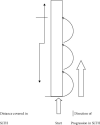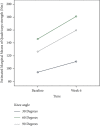Efficacy of Patellar Taping and Electromyographic Biofeedback Training at Various Knee Angles on Quadriceps Strength and Functional Performance in Young Adult Male Athletes with Patellofemoral Pain Syndrome: A Randomized Controlled Trial
- PMID: 35958675
- PMCID: PMC9359859
- DOI: 10.1155/2022/8717932
Efficacy of Patellar Taping and Electromyographic Biofeedback Training at Various Knee Angles on Quadriceps Strength and Functional Performance in Young Adult Male Athletes with Patellofemoral Pain Syndrome: A Randomized Controlled Trial
Abstract
Background: The severity of the articular lesion is the single most essential element in investigating the extent of flexion that is required for activities. However, a prior study found no differences in muscle strength gains of quadriceps muscles at different knee angles in people with patellofemoral pain syndrome (PFPS).
Objective: The effects of patellar taping and electromyographic biofeedback (EMG-BF)-guided isometric quadriceps strengthening at different knee angles (e.g., 30°, 60°, and 90° of knee flexion) on quadriceps strength and functional performance in people with PFPS were compared in this single-blind randomized controlled parallel trial.
Methods: Sixty adult male athletes with PFPS (age: 26.9 ± 1.4 years) were randomly divided into two groups. The experimental group (n = 30) received patellar taping and EMG-BF-guided isometric contraction exercise at 30°, 60°, and 90° angles, and the control group (n = 30) received sham patellar taping without EMG-BF-guided exercises for six weeks. Pain intensity, knee function, muscle strength, and the single-leg triple hop (SLTH) test were assessed.
Results: The pain intensity and SLTH scores between the groups were significantly different at the end of the trial (p ≤ 0.001). The EMG-BF and control groups had mean pain scores of 1.3 (0.8) and 4.5 (0.8), respectively. The EMG-BF and control groups had mean functional scores of 80.4 (5.1) and 69.1 (6.1), respectively. The mean SLTH score for the EMG-BF group was 540.7 (51.2) and for the control group it was 509.4 (49.8) after the trial. Quadriceps muscle strength was significantly higher in those who performed quadriceps strength training at 60° of knee flexion after six weeks than in those who performed strength training at 30° or 90° of knee flexion.
Conclusion: The findings indicated that individuals who trained their quadriceps at a 60° knee angle had significantly stronger quadriceps muscles than individuals who trained at 30° or 90° of knee flexion. Trial Registration. This trial is registered at Clinical Trials.gov under the identifier NCT05055284.
Copyright © 2022 Shahnaz Hasan et al.
Conflict of interest statement
The authors of this paper claim that there were no conflicts of interest in connection with the research that was carried out and detailed in this publication.
Figures








Similar articles
-
The effect of patellar taping combined with isometric strength training on pain, muscle strength, and functional performance in patients with patellofemoral pain syndrome: a randomized comparative study.PeerJ. 2025 May 12;13:e19381. doi: 10.7717/peerj.19381. eCollection 2025. PeerJ. 2025. PMID: 40376557 Free PMC article. Clinical Trial.
-
Efficacy of Electromyographic-Biofeedback Supplementation Training with Patellar Taping on Quadriceps Strengthening in Patellofemoral Pain Syndrome among Young Adult Male Athletes.Int J Environ Res Public Health. 2021 Apr 23;18(9):4514. doi: 10.3390/ijerph18094514. Int J Environ Res Public Health. 2021. PMID: 33922866 Free PMC article. Clinical Trial.
-
Effects of neuromuscular training on pain intensity and self-reported functionality for patellofemoral pain syndrome in runners: study protocol for a randomized controlled clinical trial.Trials. 2019 Jul 9;20(1):409. doi: 10.1186/s13063-019-3503-4. Trials. 2019. PMID: 31288849 Free PMC article.
-
A review of the management of patellofemoral pain syndrome.Phys Sportsmed. 2013 Sep;41(3):19-28. doi: 10.3810/psm.2013.09.2023. Phys Sportsmed. 2013. PMID: 24113699 Review.
-
Effectiveness of therapeutic electromyographic biofeedback after orthopedic knee surgeries: a systematic review.Disabil Rehabil. 2022 Jul;44(14):3364-3372. doi: 10.1080/09638288.2020.1867904. Epub 2021 Jan 8. Disabil Rehabil. 2022. PMID: 33417500
Cited by
-
The effect of patellar taping combined with isometric strength training on pain, muscle strength, and functional performance in patients with patellofemoral pain syndrome: a randomized comparative study.PeerJ. 2025 May 12;13:e19381. doi: 10.7717/peerj.19381. eCollection 2025. PeerJ. 2025. PMID: 40376557 Free PMC article. Clinical Trial.
-
Influence of Pain, Risk Factors, and Functional Ability on Physical Activity Levels in Women with Anterior Knee Pain: A Cross-Sectional Study.Medicina (Kaunas). 2024 Sep 7;60(9):1467. doi: 10.3390/medicina60091467. Medicina (Kaunas). 2024. PMID: 39336508 Free PMC article.
-
Effects of plyometric vs. strength training on strength, sprint, and functional performance in soccer players: a randomized controlled trial.Sci Rep. 2023 Mar 14;13(1):4256. doi: 10.1038/s41598-023-31375-4. Sci Rep. 2023. PMID: 36918731 Free PMC article. Clinical Trial.
References
-
- Kim H., Song C. H. Comparison of the VMO/VL EMG ratio and onset timing of VMO relative to VL in subjects with and without patellofemoral pain syndrome. Journal of Physical Therapy Science . 2012;24(12):1315–1317. doi: 10.1589/jpts.24.1315. - DOI
Publication types
MeSH terms
Associated data
LinkOut - more resources
Full Text Sources
Medical
Miscellaneous

